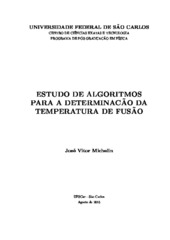Estudo de algoritmos para a determinação da temperatura de fusão
Resumen
In this work, we studied the main methods used in molecular dynamics simulations to obtain the melting temperature of crystalline materials. The methods evaluated were the solid-liquid coexistence, mechanical melt of bulk, melt with surfaces, Lindemann criterion and the method of hysteresis. The potential that we used were the Lennard- Jones for argon, the Embedded Atom Method for copper, the potential of Born-Mayer-Huggins for sodium chloride and the potential of Stillinger-Weber, Modified Embedded Atom Method and EDIP for silicon. We perform all simulations in NPT ensemble and obtained results with good agreement with literature. Some method showed better performance for specific types materials, as in the case of surface melt for copper. The method hysteresis showed fantastic results, proving to be a good alternative to traditional methods to obtain the melting temperature, as the phase coexistence. The results showed that the choice of appropriate interaction potential is a highly determining factor for obtaining good results for studying the properties of interest.
